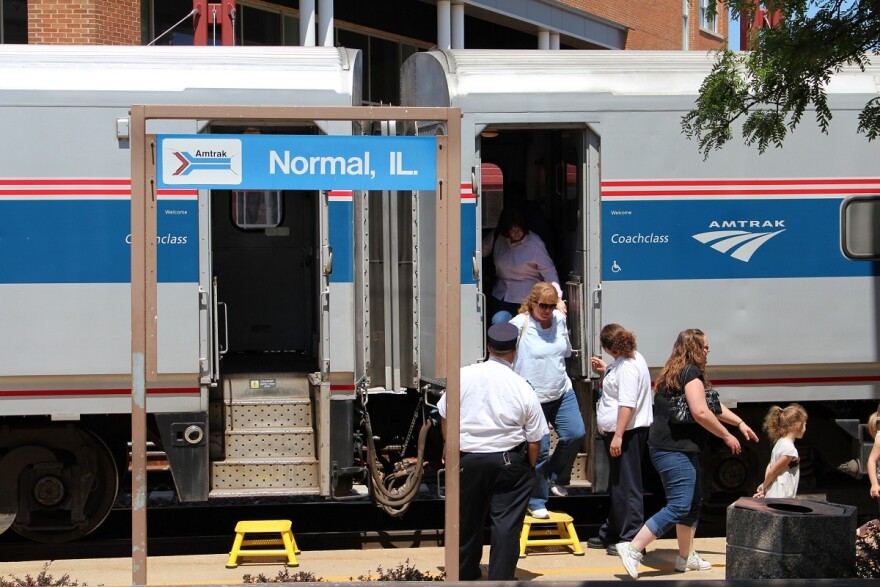A planned annual 2% increase in Town of Normal water rates in each of the next six years may not be enough to maintain adequate fund balances.
That's according to finance director Andrew Huhn, who spoke at Monday's town council meeting about the town’s Community Investment Plan. Huhn said it will be one of the topics for the council during consideration of the annual budget on Jan. 21.
Mayor Chris Koos said it's too early to say whether the town will increase the size of the scheduled water rate hike.
"What we'll look at is, we periodically do an independent evaluation of our water and sewer system to get a good look at what we're doing. We have over the years worked very hard at maintaining our water infrastructure," Koos said on WGLT's Sound Ideas.
Koos said other communities that have skimped on water spending are ending up paying much more to fix things than if they had regularly maintained their systems.
“In some situations where they have privately-owned water services, they’re noticing deterioration of the system. It’s not being maintained the way it should," he said.
Sewer fund reserves also are projected to sag some over the six-year period, said Huhn, though Koos said that area might not rise to the level of actual concern.
“I would call that a watchful category. We’re continuing to re-line sewers. It’s the same philosophy we have for water. If we start slacking on that, we may save a little money on the short term but the cost to the taxpayer over the long term is always higher,” said Koos.
The town gets federal money via the Community Development Block Grant program [CDBG] that it uses for a variety of projects. With the new Trump administration starting later this month signaling budget cuts, Koos said the town will pay attention to federal programs as well.
“I wouldn’t say I’m worried, but in a new administration you have no idea what’s coming down the pike. Especially in this administration coming in, there’s a lot of ifs. There’s a lot of promises for drastic action. Whether that can happen or not remains to be seen,” he said.
Amtrak
Koos is close to finishing his first year on the national board of Amtrak, the passenger rail service. He was told it would take him a year to learn the job and over that time his perspectives have shifted, even though he has a long history of interest in rail issues.
“The challenges of aging infrastructure. I knew it was there, but I had no idea how much need there is, in the national systems for infrastructure improvement, for rolling stock improvement," said Koos. "We have train sets that were built in the 1970s. To Amtrak’s credit, their maintenance people have an incredible ability to rework those pieces of equipment, but there is a diminishing return on that.”
He also said Amtrak’s dynamic with states to support routes like the Chicago-to-St. Louis corridor in Illinois is complex.
“You have 20-30 different DOTs, departments of transportation, at the state level that may have different ideas about what their state needs, or doesn’t need in terms of passenger rail,” said Koos.
He said Amtrak is doing well. Record ridership [+15% from FY 2023] totaled 32.8 million passengers, according to minutes from Amtrak’s annual public meeting in December.
“We’re going to see some significant increases in ridership when the new Acela trains get on the northeast corridor," said Koos, adding, “One thing I’d like to work on is there was always an idea that the Chicago-to-St Louis line would get 1-2 more trains per day. That was killed under the [former Gov. Bruce] Rauner years, and I’d like to revisit that and see if that’s a possibility.”
He said the fact Amtrak is regaining ridership lost to COVID is an important story. Before the pandemic, there was interest in the state in adding to those lines and there could be again.
“I think it’s a matter of reviving the concept and getting the conversation going again,” said Koos. “There was record ridership on the Illinois service and we see that continuing to grow. The demand is there.”
Koos also cited growth in the Chicago-to-Carbondale route through Champaign, and the western routes that include Galesburg and Macomb.
Amtrak reported record revenue for the fiscal year of $3.6 billion [+8%] yet still had a net loss of $1.8 billion made good by government subsidies. Amtrak leaders said last month there was significant improvement, but the service hit roughly a third of its performance incentive targets.
“For 2022 and 2023, Amtrak reduced its net losses at a higher rate than most passenger transportation companies in their comparator group [i.e., JetBlue, Frontier, SkyWest, and Hawaiian],” said Amtrak documents.
In safety, there were zero accidents that required National Transportation Safety Board involvement, unlike the previous year that saw a significant derailment with fatalities.


